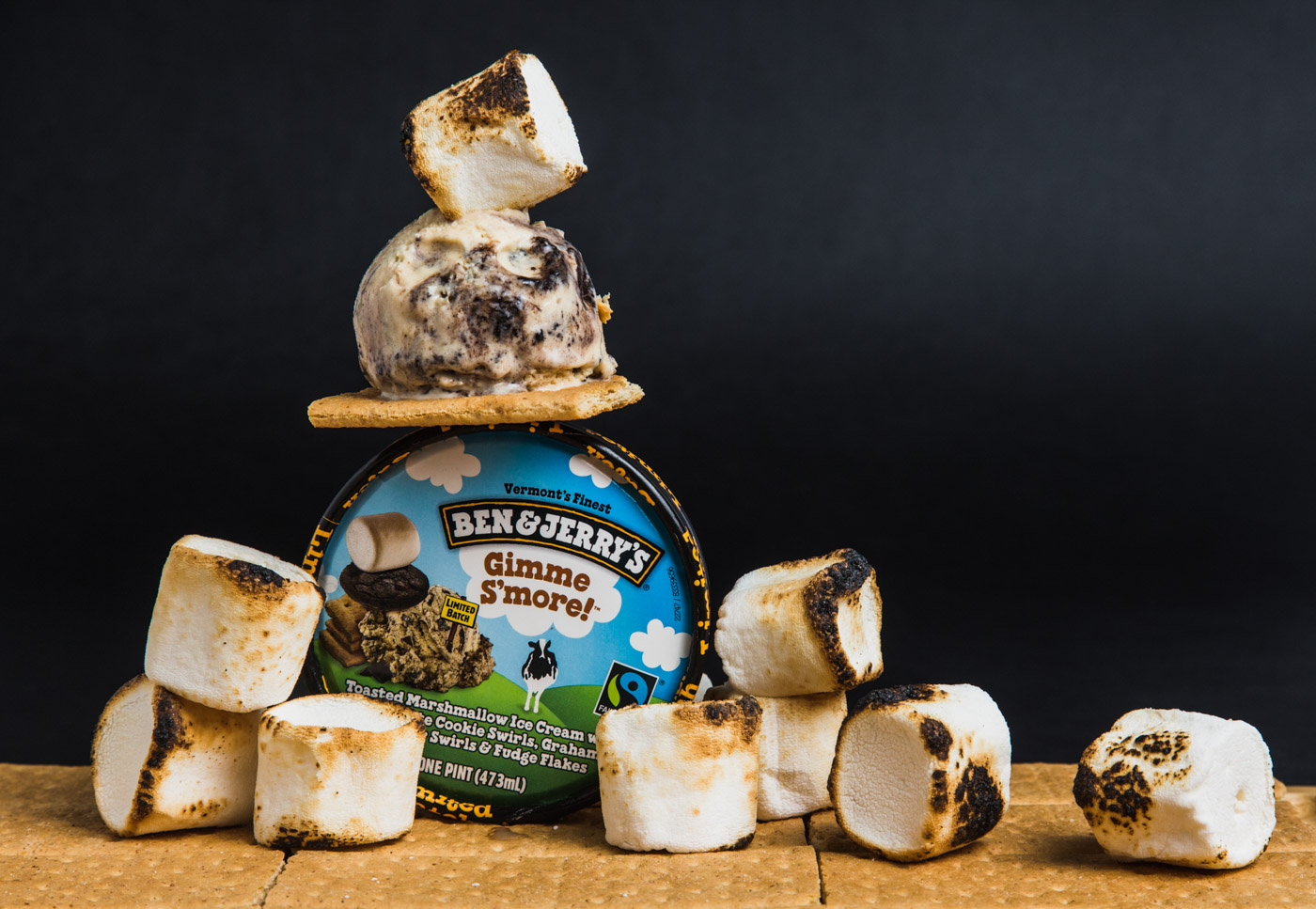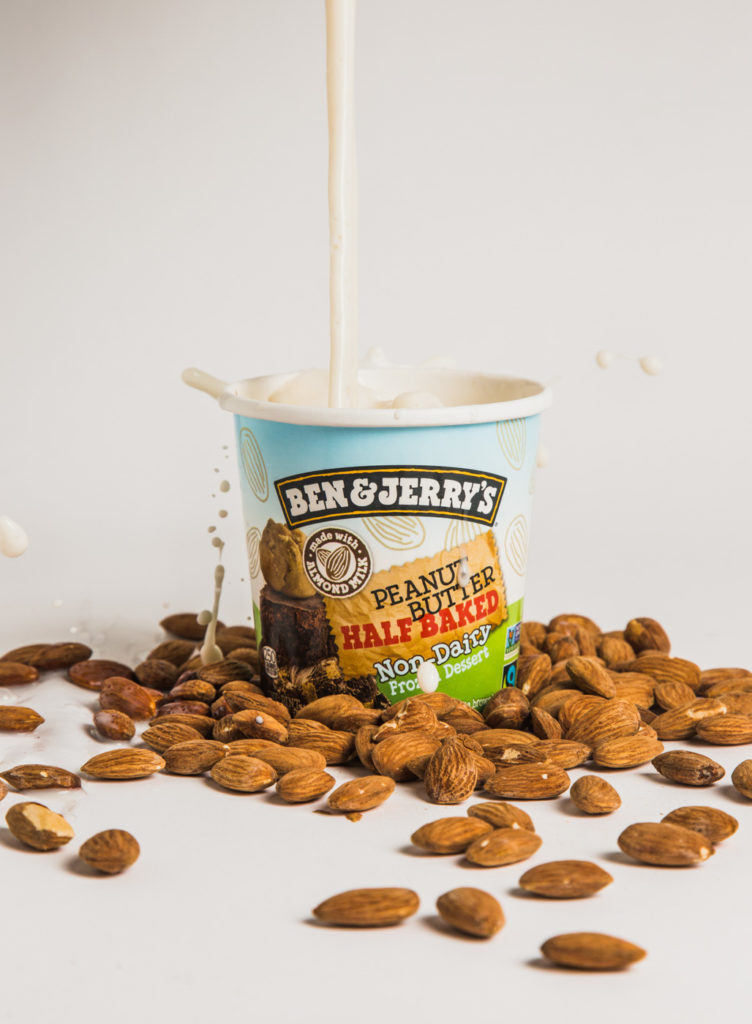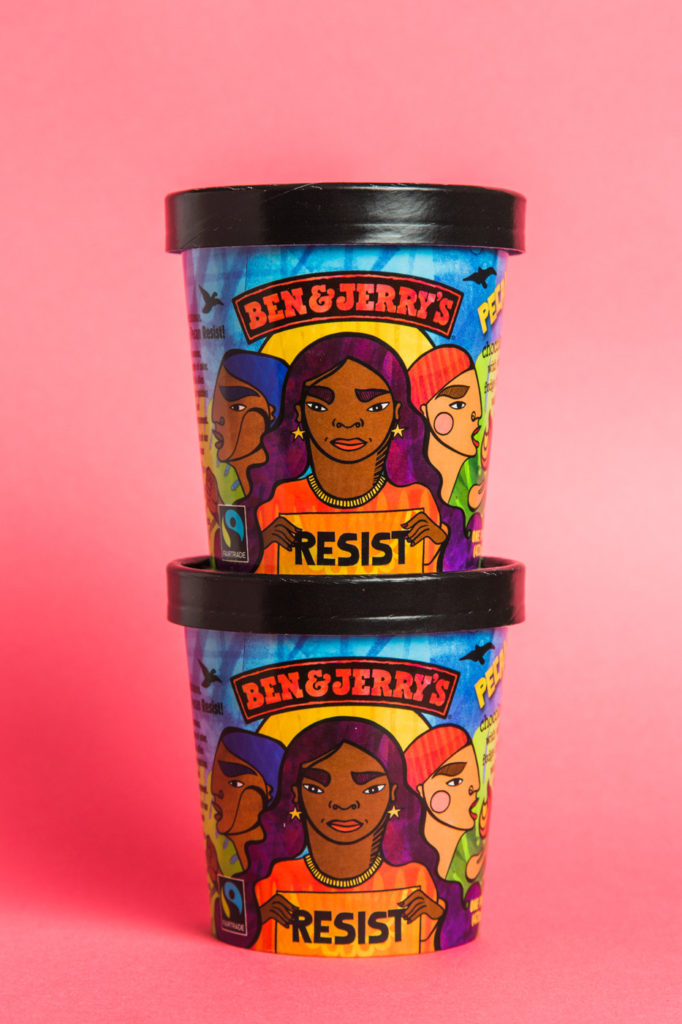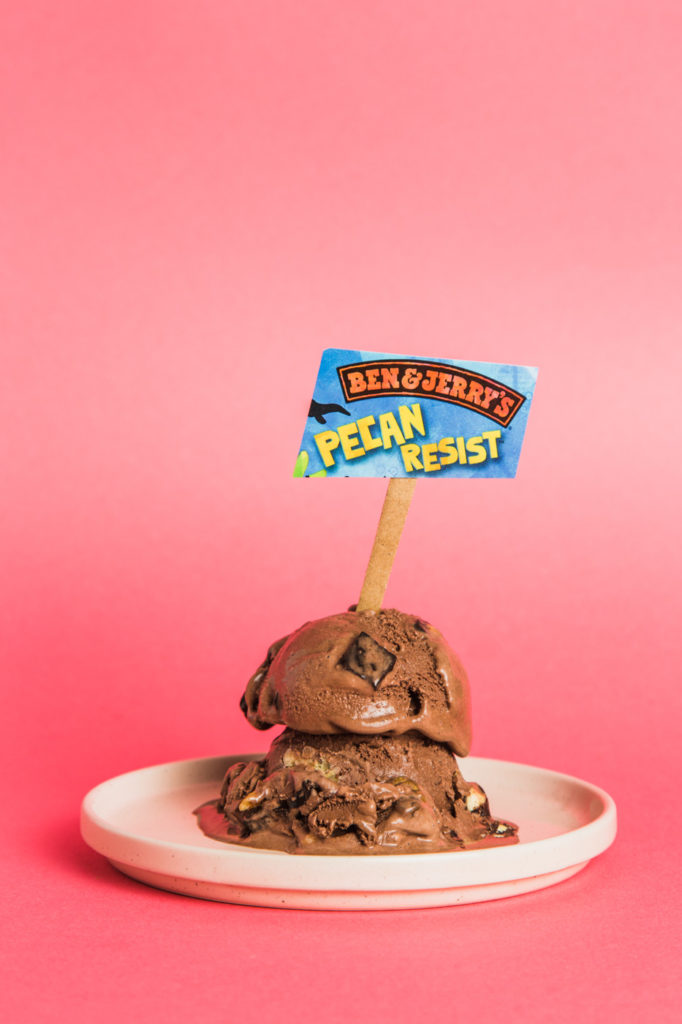
March 22, 2019
Pioneering Values-Led Business with Ben & Jerry’s
A pioneer in values-led business practices, Vermont-based Ben & Jerry’s continues to make social impact with its innovative products, as well as partnerships in its supply chain.
Words by Stef Ferrari
Photography by Katrina Frederick
On November 6, 2018, a supermajority of more than sixty percent in the state of Florida passed an initiative known as Amendment 4. The Voting Rights Restoration for Felons Initiative (its full name) was “a proposed ballot initiative that would allow people who’ve paid their debt to society to earn back their right to vote,” according to the ACLU of Florida.
“I was driving into work the morning after midterm elections and heard that it had passed,” says Sarah Fidler when I speak to her. “It was one of those moments where I was like, ‘I’m really proud to work for a company that puts so much effort into such a great cause, and that we really followed through.’”
The company of which she’s speaking created a whole campaign around raising awareness for Amendment 4, including a “Yes on 4 Truck Tour” in Florida that lasted more than two weeks. Once the initiative was passed, her employer continued its efforts, turning toward the work of encouraging the registration of 1.4 million newly eligible voters through its website and social media channels.
But Fidler’s job isn’t in politics. It’s not in organizing or advocacy. In fact, she doesn’t even live in Florida; she resides in Vermont. “I’m not a grassroots social mission organizer. It’s not who I am, but it is something I care about,” she says. “To be able to take who I am and contribute in some way to a company that is working toward making the world a better place—that’s a great thing.”
That company takes an active stance in an array of social issues: Amendment 4. Black Lives Matter. Rainforest deforestation. Implicit bias. LGBTQ rights. What do all these things have in common? Would you believe me if I told you it was ice cream?
Fidler is one of eight people with a very unique title: Flavor Guru. And the company of which she is so proud to be a part of is Ben & Jerry’s. Her role is in flavor development; it’s about keeping her finger on the pulse of what consumers want to see in their pints, about research and development, and about quality control (“We have three or more board meetings per year and at each meeting we present new flavors and for each flavor we have to say whether we have met the standard for chunks and swirls,” she says).
Fidler is responsible for upholding the product standards that were set when Ben & Jerry’s was founded in 1978 in Burlington, Vermont, and innovating upon them. That’s where the factory is based, and where Fidler works—about fifteen hundred miles from where the effects of passing Amendment 4 will be felt. “We’re not at all related to Florida other than selling ice cream there,” she says. But the culinary school graduate, who holds a bachelor’s degree in food science, finds professional pride not only in the flavors she develops and sees on shelves around the world, but in the mission at Ben & Jerry’s. “It was a proud moment just to be a part of this company,” she continues. “And it’s one of the reasons I wanted to work here.”

Mission Control
In 2017, a study by Cone Communications on corporate social responsibility reported that eighty-six percent of consumers in the United States want to see brands focus at least some of their energy on social and environmental issues.
But in 1988, when a small Vermont-based ice cream company released a flavor called Rainforest Crunch, they were an anomaly. Sean Greenwood, the Grand Poobah of Public Relations for the company, began working at a Ben & Jerry’s Vermont scoop shop in the 1980s. He recalls that flavor being one of the company’s first forays into creating a product that would “fold in this concern for being a better business.”
The concept for the flavor was to increase economic demand for rainforest nuts while raising awareness of rainforest deforestation. That was an early effort with which Ben & Jerry’s was pioneering the concept of a values-led businesses; it has since been witness to an evolution of the movement it helped initiate. “Thirty years ago, [customers cared that you] have a great quality product, and there was no judgement for what the business did for operations,” Greenwood says.
Today, so many modern businesses are now being founded with mission-driven, values-led philosophies. But Ben & Jerry’s admits it took the company some time to hone its own. “What we found in all truth was that we were all over the board, because there’s so much need,” Greenwood says. “It took us ten years to draft our mission statement, which we still use today.” Specifically, the Ben & Jerry’s mission focuses on using their business voice for equity. “How do we stick up for people who are marginalized?” Greenwood posits.
After Rainforest Crunch, Ben & Jerry’s spread its socially conscious wings to other concerns. During the Cold War, they advocated for One Percent for Peace, a group organized by founder Ben Cohen, which proposed that one percent of the military budget be redirected for peaceful negotiations. According to the book, Ben & Jerry Double Dip: How to Run a Values Led Business and Make Money, Too by Cohen and Greenfield, “The Peace Pops episode was destructive in certain immediate ways, but overall its effects were constructive. It was a watershed event in the life of Ben & Jerry’s.” The initiative broke ground for the company, and the book notes it allowed them to more easily assert their values going forward.
These days, we don’t ask too many questions when a business asserts its views and values, but taking that stance was riskier thirty to forty years ago. Greenwood remembers they had to ask themselves, “Should we be taking this stance? We want to say we believe in peace, but will it alienate people who support the government or support the military? How do we find a middle ground to be able to talk about this?” There was no precedent to which they could refer.
And of course, not all of their efforts were received with public praise and positivity. Around the time they were taking on environmental concerns in the rainforest, Ben & Jerry’s was looking internally at the LGBTQ community—one which they’ve been consistently supporting for more than three decades. In 1989, they became one of the first employers to offer benefits to same sex partners. In 2009, when same sex marriage was legalized in Vermont, the company renamed the classic flavor Chubby Hubby to Hubby Hubby, set up shop outside the county clerk’s office, and offered free ice cream to couples exercising their newly minted rights. And in 2015, when gay marriage was legalized nationally, Chocolate Chip Cookie Dough was briefly rebranded I Dough, I Dough to commemorate the occasion.
“We’d get hate mail,” Greenwood remembers. More recently, they’ve been met with similar backlash regarding their continued political stances. “When we decided to take a stand to say we supported the Black Lives Matter movement,” Greenwood remembers receiving letters with sentiments claiming, “‘I think this is liberal bull, there’s no racism problem, everyone has the same opportunity in our country,’” he recalls. “We said, ‘We respectfully disagree with that.’”
Occasionally, the offending issues are of a slightly less sensitive nature. In 2011, Schweddy Balls—a flavor made with malt balls and rum balls—was released in honor of the iconic Saturday Night Live sketch, and incited some who felt Ben & Jerry’s was simply in it for the shock value. But Greenwood says their brand has also been about having a sense of humor, and balancing the more serious efforts with a sense of irreverence.
If nothing else, being outspoken has encouraged conversation with consumers. Greenwood says ideally, “We would want that to be a respectful dialogue when possible.” But as Ben & Jerry’s has grown, it has become an increasingly indispensable component of their philosophy. “It’s not only an opportunity, but it’s a responsibility for us if we’re going to be a business that says it stands up for what it believes in.” And ruffling some feathers along the way is simply a part of the process. “As long as we’re making a decision that feels consistent with our values, we’re okay with that.”

In the Mix
For most of its customers then and now, the social mission is likely just the cherry on top. Ice cream is the core of the business and Ben & Jerry’s has been innovative in more than just its social justice initiatives; they’ve never been shy about pushing boundaries with products either. Chocolate Chip Cookie Dough may be an ice cream now commonly found in freezers all over the world, but before a Ben & Jerry’s scoop shop began offering it as a topping, the classic flavor didn’t exist.
Following that thread of chocolate chip cookie dough’s invention exemplifies another pillar of the Ben & Jerry’s business model—its supportive relationship with each link in their supply chain. When I speak to Ted Castle, owner and president at Rhino Foods, a Vermont-based supplier of ice cream and frozen dessert mix-ins, I’m given some more insight into what that collaboration looks like.
The tale begins back in the early nineties, around the time of that flavor’s invention. Castle had founded a small ice cream shop in Vermont, but eventually began selling his brownie batter and cookie dough to accounts like Ben & Jerry’s. It was brought to his attention that the R&D team at Ben & Jerry’s was considering putting cookie dough into a pint, as one of their scoop shops had been adding the topping to in-store orders and having a great deal of success.
Castle remembers, “It took about a year and a half to figure out how to get gooey, chewy cookie dough into an ice cream and have it distributed throughout the pint.” In those days, the equipment was only developed for inclusions like chocolate chips, or variegates like fudge or jam.
Once they cracked the cookie dough code, the flavor was an immediate sensation. “Once they put it on the shelves, one out of every four pints of Ben & Jerry’s was cookie dough,” says Castle. Today, Castle tells me they now supply sixty percent of ice cream companies using cookie dough in their products.
Rhino Foods credits Ben & Jerry’s for bolstering their product success, but also inspiring their philosophy. “I believe they really influenced us to look at the business from a socially responsible perspective,” he says.
Rhino Foods’ mission is “To impact the manner in which business is done,” and focuses on four main principles: Community, Community/Supplier, Employee and Finance. Their efforts have evolved over the years, but have included initiatives like an income advance program for employees, as well as open-book management, which was implemented three decades ago.
The focus on employee success is shared with another Ben & Jerry’s supplier, Greyston Bakery in Yonkers, New York, where the mission is “to create thriving communities through the practice and promotion of open hiring,” as President and CEO Mike Brady tells me.
Greyston’s packages would be familiar from Delta Airlines passengers to Whole Foods shoppers; in the Ben & Jerry’s narrative, their presence is found in the form of those chunks that make flavors like Chocolate Fudge Brownie classic customer favorites. But Greyston’s delicious confections are really a medium through which to support its community.
“We don’t hire people to bake brownies; we bake brownies to hire people,” Brady says. Coincidentally, Greyston’s approach shares some fundamental DNA with that objective of Amendment 4; however, they’ve been working to that end for decades with their open hiring philosophy. Brady continues, “That is the mission of the organization: to take someone who may never have the opportunity to work, provide them access to a job, and then as we help them to be successful on a job, hopefully make them a thriving part of our community in southwest Yonkers.”

Their philosophy helped forge the initial relationship between the bakery and Ben & Jerry’s. Greyston founder Bernie Glassman, a zen monk intent on infusing his business with his Buddhist philosophies, met Ben Cohen twenty-seven years ago at a retreat for social venture networks. “[They] had a meeting of the minds on what it meant to create a business that was not only going to make great products, but give back to the community,” Brady explains. “Our missions have evolved over time, but the ethos of the founders remain to this day so tightly tied.”
All three companies are also Certified B Corporations, which according to the B Corp website, is made up of “people using business as a force for good,” who are “legally required to consider the impact of their decisions on their workers, customers, suppliers, community, and the environment.” The B Corp movement began in 2006, long after these three businesses had codified their own sets of philosophies, but each has seamlessly integrated into a network of more than 2,500 B Corp certified global businesses today.
More Than a Half Baked Idea
Without Ben & Jerry’s, Greyston Bakery and Rhino Foods, the world wouldn’t have Half Baked (vanilla and chocolate ice cream with chunks of Greyston brownies and Rhino Foods’ cookie dough—a Ben & Jerry’s fan favorite). For consumers who have grown increasingly socially conscious, knowing a single pint supports all three of their endeavors makes for a pretty powerful purchase.
But it’s not all about flavor, or even social impact; these companies have proven that doing good is just good business sense. For Ben & Jerry’s, it may have been the differentiating factor they needed to become market leaders. “Launching these flavors associated with issues they cared about allowed people to connect to the company in the way they wouldn’t connect with other businesses,” Greenwood says.
Brady speaks specifically to the benefits of Greyston’s open hiring philosophy. “We’ve continued to evolve [the model] and demonstrate that not only is it good for the community, but it’s good business. There are true value adds to having an open hiring model that I want other business leaders to understand,” he says. “They can create a tremendous workforce, create a culture that’s welcoming, save money in their HR models,” says Brady. He adds that statistically, the Society for Human Resource Managers estimates about a $4,200 average cost-per-hire. By contrast, he tells me, “On average, our cost is about $1,900.”
Castle’s experience is similar. “Fundamentally, what people call these ‘feel good’ business practices could come down to return on investment,” he says. He notes their income advance program has helped increase employee retention by twenty-eight percent. “Are we doing it because we’re trying to help our employees who are living paycheck to paycheck, who don’t have $1,000 to help with an emergency? The answer is yes,” he says. But the benefit is mutual: “They show up to work, they can get through those emergencies, and they appreciate the company that helped them do it.”
At the end of the day, a business is only able to make an impact if they’re accomplishing what’s necessary to their bottom line. “We have to be concerned with money because it’s part of our business,” says Greenwood. With transparency, each of these businesses hope to prove that having good intentions and being a profitable business doesn’t have to be incongruous. Those social messages can only reach so far in the hands of a small business; it is the success of the enterprise which has been instrumental in giving Ben & Jerry’s a much larger megaphone.
A Parental Approach
People have a tendency to think about business acquisition the way they feel about indie bands going mainstream—like there’s some loss of soul. Which is why, when Unilever acquired Ben & Jerry’s in 2000, many wondered if things would go south.
The strategy to sell was never part of Cohen & Jerry Greenfield’s original strategy for their ice cream business. There were a number of offers over the years, but if they did accept, he says, it would have to be to a company that best supported the social mission. Until Unilever came knocking, no one met that criteria.
As part of the sale, unique structural checks and balances were put in place to ensure continuity with the company’s vision. “We were the only business acquired by Unilever to work into the agreement to have its own independent board of directors,” says Greenwood. That board is made up primarily of activists. He says their responsibility on the board is to uphold brand equity as well as social mission.
And whether the company had an influence on its new parent company, or Unilever has responded to a more general shift in their industries, Greenwood feels those ideals are more in line than ever. “When you look at what Unilever has been doing over the last ten years under the leadership of [chairperson Paul Pullman], they are so much more active, they support smallholder farming, gender issues, and working with the U.N.,” he says. “They’re tackling these really big opportunities to be a values-led business, and I truly feel it is.”


Going Forward
Today, Ben & Jerry’s may be more active than ever given their amplified platform with Unilever’s global reach. In 2018, they released a new flavor called Pecan Resist. The website description explains the idea behind the flavor: “We can peacefully resist the Trump administration’s regressive and discriminatory policies and build a future that values inclusivity, equality, and justice for people of color, women, the LGBTQ community, refugees, and immigrants. Pecan Resist supports four organizations that are working on the front lines of the peaceful resistance, building a world that supports their values.” The limited batch flavor benefitted four partner organizations: Color of Change, Honor the Earth, Neta and Women’s March.
If there was ever a question whether the company would cave to corporate pressure, these examples demonstrate Ben & Jerry’s retained focus on those marginalized populations, and perhaps they’re bolder than ever before. “We know we can’t save the world with everything,” Greenwood says. With time, Ben & Jerry’s has honed in on a few key issues. “In the last four or five years in the U.S. we’ve been focusing on racism,” he continues, citing one example.
They’ve refined their approach, understanding as an ice cream company, they benefit from the consultation of experts in the areas they wish to support. Greenwood says, “We consider ourselves ice cream experts, so we go to folks who are experts around race, organizations like Color of Change.” Ben & Jerry’s works with those organizations to understand how their work can have the most impact. “They’ll help direct us to the right area where we can be resourceful, so it’s not just Ben & Jerry’s doing some greenwashing campaign.”
To that end, Greenwood says Ben & Jerry’s is trying to be proactive in combating implicit bias and developing a more diverse future for the company, situated in what Greenwood recognizes is “one of the most notoriously white states in the union.” In an effort to widen their talent pool, they’ve looked outside their immediate surroundings. “We’re working with Howard University out of D.C. to look at a pipeline as a way to bring more people of color to our workforce here.”
In Yonkers, Brady describes the hopes for Greyston’s continued efforts as well. “Greyston Foundation has been recently repositioned to launch The Center for Open Hiring at Greyston, and that’s to teach other businesses how to take open hiring,” he says. “Instead of the 110 folks at our bakery, we can influence thousands—maybe millions—of people facing barriers to employment.”
He acknowledges the importance of businesses with shared missions supporting one another in order to achieve these objectives. “That is possible because of the relationship between the bakery and Ben & Jerry’s.” Brady contends, “I’ve never seen an organization walk the walk of what they’re trying to accomplish better.”
Greenwood believes the real value is in sharing stories—of success and otherwise—in order to inspire a greater global network of companies that share values. “It’s not a perfect place here,” he says. “But anybody can try to incorporate values in our business. We want to share what we’ve done, and if other businesses can do that and we all have a greater impact on society, that’s excellent.”
On a recent trip to Italy, I visited a gelateria where scoops of a cookie dough flavor were on offer. As the world gets a little bit smaller, if a flavor can make its way from New England to a little shop halfway around the world, is it conceivable that a philosophy, a business practice, or a support system can follow?
From Vermont to New York to Florida—even to international freezers—Ben & Jerry’s has made its employees proud, its suppliers inspired, and its customers infinitely satisfied for more than four decades.






Our comments section is for members only.
Join today to gain exclusive access.